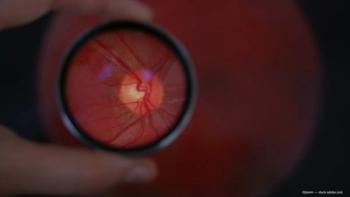
Corneal crosslinking shows favorable long-term outcomes
Studies with follow-up of 2 to 6 years show that corneal crosslinking for progressive keratectasia is safe and induces long-term structural changes.
Take Home
Studies with follow-up of 2 to 6 years show that corneal crosslinking for progressive keratectasia is safe and induces long-term structural changes.
Dr. Seiler
By Cheryl Guttman Krader; Reviewed by Theo Seiler, MD, PhD
Zurich, Switzerland-Results from 5 years of follow-up support the efficacy and safety of
The data, Dr. Seiler said, shows that CXL results in a significant keratometric flattening effect that is stable in most eyes, while causing minimal complications or significant best spectacle-corrected visual acuity (BSCVA) loss.
“CXL induces structural changes in the cornea that may continue for many years,” said Dr. Seiler, professor of ophthalmology, University of Zurich, and Chairman, IROC Zurich, Switzerland. “However, do not forget that (these) long-term results . . . are based on treatment with the Dresden protocol using an epithelium-off technique.
“They may not apply to epithelium-on and other procedures,” he added.
CXL safety
In evaluating the safety of CXL, Dr. Seiler said he first used the criterion of a ≥2 line loss of Snellen BSCVA that is used by the FDA as a marker for complications. In a series of more than 100 eyes treated with CXL, the rate of BSCVA loss of 2 or more lines at 1 year was 1%, and risk factors for that outcome were age >35 years and better baseline vision (20/25 or better).
Dr. Seiler noted that failure of treatment to prevent disease progression is more difficult to identify considering inherent keratometric measurement error.
Using a criterion of a Kmax increase ≥1 D-which represents >3 standard deviations of the measurement error-the 1-year failure rate in the same cohort of eyes was 3%. The only preoperative risk factor identified for failure was advanced keratoconus (Kmax >58 D), although Dr. Seiler noted there are many examples of eyes with severe keratoconus that benefit with significant flattening after CXL.
At 1 year postCXL, Dr. Seiler reported that 35% of eyes treated with the standard irradiation protocol (3 mW/cm2 for 30 minutes) using older UVA technology (UV-X 1000, IROC Innocross) achieved Kmax flattening >1 D. However, success in achieving that outcome has been increased dramatically to 91% using a newer device that features an optimized beam profile (UV-X 2000, IROC Innocross).
Looking long-term
Reviewing longer-term outcomes, Dr. Seiler cited a study from his original Dresden group that included data from 241 eyes with a mean follow-up of 27 months. The data reported a 2-year failure rate of 2% [J Cataract Refract Surg. 2008;34(5):796-801]. However, in a study by O’Brart et al. [Br J Ophthalmol. 2013;97(4):433-7] that included 40 eyes which were followed for 4 years, there were no cases with a Kmax increase ≥1 D.
“These are essentially very favorable long-term results and indicate CXL is a very effective procedure,” Dr. Seiler said.
Data on long-term complication rates vary from 0% in the study by O’Brart et al. to 13.7% as reported by Hashemi et al. in a series of 40 eyes which were followed to 5 years [Ophthalmology. 2013;120(8):1515-20].
“Likely the true complication rate lies somewhere in between,” Dr. Seiler said.
Data on keratometric flattening from the studies by O’Brart et al. and Hashemi et al. show the results are stable with some minor continued flattening over the long-term. However, Dr. Seiler stressed that more dramatic progressive flattening might be observed in occasional patients.
Theo Seiler, MD, PhD
Dr. Seiler is a scientific consultant to Alcon/Wavelight.
Newsletter
Don’t miss out—get Ophthalmology Times updates on the latest clinical advancements and expert interviews, straight to your inbox.









































